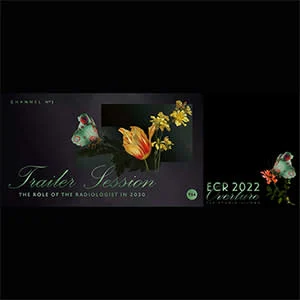At this year’s ECR Overture, session panellists discussed their vision of radiology’s future. Panellists debated methods for easing workloads, radiologist specialisation, the value of attending multidisciplinary team meetings, and the future impact of artificial intelligence (AI) on radiology departments over the coming years. The session was moderated by European Society of Radiology (ESR) president, Dr Regina Beets-Tan and Chairman of the ESR Board of Directors, Dr Michael Fuchsjäger.
Prof Andrea Rockall (Imperial College London) first presented results from the ESR membership survey conducted from 2019 to 2020. The survey asked ESR members about their clinical role, training, and professional relationships.
The survey suggested that radiologists highly value a period of clinical training. The survey found that 80% of the respondents felt that radiologists should train for a compulsory period in a non-radiology clinical setting, either before or during radiologist training. Similarly, 70% indicated that they had already received some medical training in a non-radiological clinical setting.
Radiologists may likely become more sub-specialised since this is important for job satisfaction and visibility. While over 90% thought subspecialisation was important for radiologists, only 47.5% pursued subspecialist training or a clinical fellowship. Survey respondents (over 84%) believed that having a subspecialty accreditation improves their identity as radiologists in their own eyes and those of their colleagues, but less (34%) felt it mattered for patients. Regarding a radiologist’s visibility as part of an organ-based service, 86.9% agreed that it was important.
Radiologist valued interactions with radiology and clinical colleagues and multidisciplinary tumour boards. On job enjoyment, while 74 to 88% of respondents enjoyed being a radiologist, the colleague and patient interactions, and teaching, almost half reported wanting a lower workload. Heavy workload is an important problem that AI may assist. However, Dr Rockall added ‘We do need to look at building our workforce’.
Great importance was placed on communication. To improve the patient experience and increase efficiency, 88.6% felt that a radiographer or radiology nurse could describe imaging procedures to patients. Many (over 80%) felt formal training for communicating bad news and significant imaging findings was needed. About 46% felt that communicating errors to the patient was an important part of the radiologists' role.
After Dr Rockell’s presentation, a panel of experts discussed upcoming trends that are expected in the coming years. Much of the discussion centred on the problem of heavy workloads for radiologists and their importance. The discussion also focused on how physician assistants and software packages can ease the work burden of radiologists. Although AI can help, Dr Emanuele Neri (University of Pisa) emphasised that AI will not replace radiologists. 'One of the main impacts of AI will be in the workflow: prioritising examinations and helping in image acquisition in terms of quality of images. I think this could save time.’ Regarding clinical interpretation, although AI tools are available, these need careful vetting because radiologists ultimately are responsible.
Caroline Justich and Erik Briers (ESR Patient Advisory Group) emphasised the need for speedy diagnosis for patients, especially when findings are critical. So clinicians must collaborate effectively and efficiently. When the requirements are less critical, plain-language explanations, as well as consistency among the care team, are important.
Source:ECR 2022 Overture






